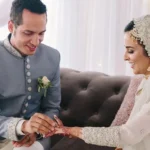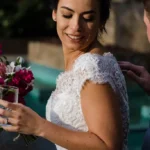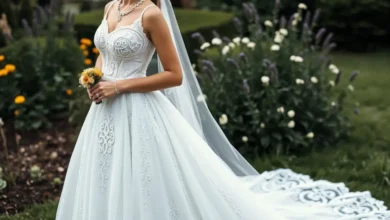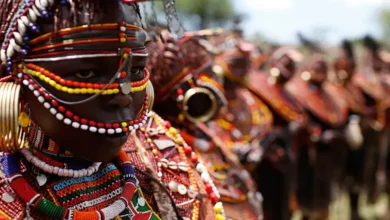From the Chinese tea ceremony to the Nigerian Gele, discover 10 fascinating and essential dress rituals from multicultural weddings around the world and the deep symbolism behind them.
Multicultural wedding rituals: A Celebration of Global Love
A wedding is more than just a party; it is a profound ritual, a tapestry woven from love, family, and tradition. And at the heart of this tapestry, you will often find the clothing. In multicultural weddings, the garments worn by the couple are not merely beautiful outfits; they are a language, a story, and a sacred link to heritage.
Around the world, the act of dressing for a wedding involves a series of deeply symbolic rituals. These are moments of transformation, where a bride or groom is not just putting on clothes, but is being adorned with blessings, protection, and the weight of their ancestral history. These rituals turn a simple garment into a vessel of cultural identity and familial love.
In this article, we will take a journey around the globe to explore 10 essential and beautiful dress rituals from multicultural weddings. You will discover:
✅ The symbolism behind the “something blue” of the West.
✅ The vibrant colors of a Hindu wedding sari.
✅ The intricate process of a Chinese tea ceremony outfit change.
✅ The powerful meaning of a Nigerian Gele headdress.
 Arab Weddings: The Mystique of Cultural Splendor
Arab Weddings: The Mystique of Cultural SplendorPrepare to be inspired by the universal language of love, expressed through the beautiful and diverse rituals of wedding attire.

🇮🇳 The Draping of the Red Sari (Hindu Wedding)
The Ritual: In many parts of India, the bride’s wedding attire is a magnificent red sari. Red is not a color of romantic love, but a symbol of deep significance. The draping of the sari itself is an art form, often done by the bride’s mother, aunts, or sisters. This act of dressing the bride is a communal moment of female bonding and the passing down of wisdom.

The Symbolism:
- Red (Lal): This powerful color symbolizes prosperity, fertility, and new beginnings. It is also associated with the goddess Durga, representing female power and strength.
- Gold Embroidery (Zari): The intricate gold threadwork represents wealth and auspiciousness, wishing the couple a prosperous life.
- The Draping: The way the sari is draped can signify the bride’s regional origin. The act of the elder women dressing the bride symbolizes their blessing and her transition from a daughter to a wife.
🇨🇳 The Changing of the Qipao/Qun Kwa (Chinese Tea Ceremony)
The Ritual: A traditional Chinese wedding often involves multiple outfit changes. One of the most significant is the change into a red dress for the tea ceremony. This is a formal ritual where the bride and groom serve tea to their elders (parents, grandparents) as a sign of respect and gratitude. The bride may wear a Qun Kwa, a two-piece embroidered gown, or a Qipao (also known as a Cheongsam), a form-fitting one-piece dress.
See also The Vibrant Beauty of Brazilian Wedding Dresses: Tradition, Culture, and Modern Flair
The Vibrant Beauty of Brazilian Wedding Dresses: Tradition, Culture, and Modern Flair
The Symbolism:
- Red: The color of luck, happiness, and joy in Chinese culture. Wearing red is believed to ward off evil spirits and bring good fortune to the marriage.
- Embroidery: The Qun Kwa is often lavishly embroidered with gold and silver thread, depicting dragons (for the groom) and phoenixes (for the bride), symbolizing a perfect and balanced union.
- The Act of Changing: The outfit change marks a transition. The bride may wear a white Western-style gown for the ceremony, but she changes into the red dress for the tea ceremony to honor her family and her cultural heritage.
🏴The Pinning of the Tartan (Scottish Wedding)
The Ritual: After the wedding vows, a poignant moment occurs. A female member of the groom’s family, often his mother, presents the bride with a sash or rosette made from the groom’s family tartan. She then pins it onto the bride’s dress.

The Symbolism:
- The Tartan: The tartan pattern is a powerful symbol of clan identity and kinship in Scotland. Each family has its own unique tartan.
- The Pinning: This simple act is a deeply symbolic gesture of welcoming the bride into the groom’s family and clan. By wearing his tartan, she is now officially one of them. It is a beautiful and visual representation of two families becoming one.
4. 🇳🇬 The Tying of the Gele (Nigerian Yoruba Wedding)
The Ritual: The Gele is an elaborate and artistic headwrap worn by women in Nigeria, particularly in Yoruba culture. For a wedding, the bride’s Gele is a spectacular creation. It is not a pre-tied hat; it is skillfully folded, pleated, and tied from a long piece of stiff fabric by a specialist artist or a knowledgeable family member. The process can take a considerable amount of time and is a key part of the bride’s preparation.
The Symbolism:
- A Crown of Honor: The Gele is considered the woman’s crown. Its height and complexity can signify her social status and the importance of the occasion.
- Aso-Ebi (Family Cloth): Often, the bride’s Gele will be made from the same fabric as the outfits of her family members, creating a beautiful visual unity and showing who belongs to her side of the family.
- The Tying Ritual: The careful and artistic tying of the Gele is an act of honor, transforming the bride and preparing her to be presented as a queen on her special day.
5. 🇯🇵 The Wearing of the Shiromuku and Uchikake (Japanese Shinto Wedding)
The Ritual: A traditional Japanese bride undergoes several layers of dressing. She first wears a white kimono known as a shiromuku. After the ceremony, she may change into a colorful and ornate silk overcoat called an uchikake.
The Symbolism:
- The White Shiromuku: “Shiro” means white and “muku” means pure. This all-white ensemble, including a white hood (wataboshi or tsunokakushi), symbolizes her purity, maidenhood, and her willingness to be “dyed in the colors of her new family.”
- The Red or Colorful Uchikake: The change into the vibrant uchikake after the ceremony symbolizes her rebirth as a wife. The red color represents luck and happiness. This ritual is a visual storytelling of her transformation.
6. 🇬🇷 The Crowning (Stefana) and the Koumbaro/Koumbara (Greek Orthodox Wedding)
The Ritual: While not strictly a dress ritual, the Stefana are central to the couple’s attire. These are two beautiful crowns, often made of flowers, silver, or gold, joined by a single ribbon. The priest places them on the heads of the bride and groom and then swaps them back and forth three times. The Koumbaro (best man) or Koumbara (maid of honor) is the one who assists in this ritual.
The Symbolism:
- The Crowns: The Stefana symbolize that the bride and groom are now the king and queen of their own home, which they will rule with love and wisdom.
- The Ribbon: The single ribbon joining the crowns represents their unbreakable unity.
- The Swapping: The three swaps honor the Holy Trinity and symbolize that their individual strengths will now be shared in their union.
7. 🇲🇦 The Kaftan and the Negafa (Moroccan Wedding)
The Ritual: A Moroccan wedding is a spectacular fashion show. The bride may change outfits up to seven times, each representing a different region of Morocco. This entire process is orchestrated by the Negafa, a professional wedding stylist and mistress of ceremonies. The Negafa and her assistants dress the bride in each elaborate Kaftan, complete with stunning jewelry and makeup.
The Symbolism:
- The Kaftan: Each Kaftan, made of rich fabrics like velvet and silk and heavily embroidered with gold thread, is a work of art. It is a symbol of wealth, elegance, and the richness of Moroccan culture.
- The Negafa: The Negafa is more than a stylist; she is a guardian of tradition. Her role is to present the bride like a queen, ensuring every detail is perfect. The ritual of being dressed by the Negafa is a rite of passage, preparing the bride for her new role.
8. 🇰🇷 The Hanbok and the Paebaek Ceremony (Korean Wedding)
The Ritual: Modern Korean couples often wear a Western-style gown and tuxedo for their main ceremony. However, for a special family ceremony called the Paebaek, they change into a traditional Hanbok. The bride’s Hanbok is particularly vibrant, often with a red skirt and a green or yellow jacket, adorned with intricate embroidery.
The Symbolism:
- The Hanbok: Wearing the Hanbok is a direct act of honoring their parents and their Korean heritage. The colors are symbolic: red for the bride, blue for the groom, representing the harmony of yin and yang.
- The Paebaek Ceremony: During this ritual, the couple bows to their parents, who are also in Hanbok, and serves them tea or wine. It is a beautiful moment of filial piety and the formal merging of two families.
9. 🇺🇸 “Something Old, New, Borrowed, Blue” (Western Wedding)
The Ritual: This is one of the most well-known Western wedding traditions, originating from an Old English rhyme. The bride is supposed to incorporate these four items into her wedding day attire for good luck.
The Symbolism:
- Something Old: Represents continuity and the bride’s connection to her family and her past. (e.g., her grandmother’s locket).
- Something New: Represents optimism for the future and the new life the couple is starting together. (e.g., the wedding dress itself).
- Something Borrowed: Represents “borrowed happiness” from a happily married friend or relative. (e.g., a friend’s veil).
- Something Blue: In ancient times, blue was the color of love, purity, and fidelity. (e.g., a blue garter or a small blue ribbon sewn into the dress).
10. 🇵🇪 The Tying of the Lliclla (Peruvian Andean Wedding)
The Ritual: In a traditional Andean wedding, the groom’s mother plays a key role. She drapes a beautifully handwoven rectangular shawl, called a Lliclla, over the bride’s shoulders and fastens it at the front with a decorative pin called a tupu.
The Symbolism:
- The Lliclla: This woven textile is a work of art, with patterns that tell stories of the community and the natural world. It is a symbol of female identity and strength in the Andes.
- The Tying Ritual: Like the Scottish pinning of the tartan, this act symbolizes the bride’s formal acceptance into the groom’s family. The groom’s mother is essentially “clothing” the bride as one of her own, wrapping her in the protection and love of her new family.
Conclusion: A Universal Language of Love
From the highlands of Scotland to the deserts of Egypt, from the bustling cities of Nigeria to the serene temples of Japan, these dress rituals share a beautiful, universal truth. They are moments of transformation, where clothing becomes a powerful vessel for love, heritage, and blessings.
They remind us that a wedding is not just the union of two individuals, but the weaving together of two families, two histories, and two cultures. And through these beautiful and diverse rituals of adornment, we see the same heartfelt wish whispered in every language and in every stitch: a wish for a future filled with happiness, prosperity, and unbreakable unity.




